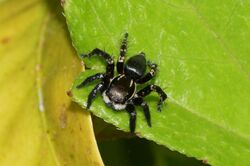Biology:Stenaelurillus modestus
| Stenaelurillus modestus | |
|---|---|

| |
| The related Stenaelurillus albus | |
| Scientific classification | |
| Domain: | Eukaryota |
| Kingdom: | Animalia |
| Phylum: | Arthropoda |
| Subphylum: | Chelicerata |
| Class: | Arachnida |
| Order: | Araneae |
| Infraorder: | Araneomorphae |
| Family: | Salticidae |
| Subfamily: | Salticinae |
| Genus: | Stenaelurillus |
| Species: | S. modestus
|
| Binomial name | |
| Stenaelurillus modestus Wesołowska, 2014
| |
Stenaelurillus modestus is a species of jumping spider in the genus Stenaelurillus that lives in South Africa. It was first described in 2014 by Wanda Wesołowska. The species is a specialist that preys on Odontotermes termites, although its venom is also effective against other prey. The spider is medium-sized, with a brown cephalothorax between 2.0 and 2.7 mm (0.079 and 0.106 in) in length and a black abdomen between 1.9 and 2.8 mm (0.075 and 0.110 in) long. It is generally black in colour. The carapace has a border of white hairs and the abdomen is edged with bristles. It is distinguished from other members of the genus by the male's elongated palpal bulb and straight embolus, and the horseshoe-shaped depression in the female's epigyne.
Taxonomy
Stenaelurillus modestus was first described by Wanda Wesołowska in 2014.[1] It is one of over 500 species identified by the Polish arachnologist.[2] It was placed in the genus Stenaelurillus, which was first raised by Eugène Simon in 1886.[3] The name relates to the genus name Aelurillus, which itself derives from the Greek word for cat, with the addition of a Greek stem meaning narrow.[4] Wayne Maddison placed the genus in the subtribe Aelurillina in the tribe Aelurillini in his 2015 study of spider phylogenetic classification, which was allocated to the clade Saltafresia.[5] In 2017, it was grouped with nine other genera of jumping spiders under the name Aelurillines.[6] The species name is a Latin word that can be translated modest.[7]
Description
The spider is medium-sized. The male has a cephalothorax that measures between 2.0 and 2.4 mm (0.079 and 0.094 in) in length and between 1.5 and 1.9 mm (0.059 and 0.075 in) in width.[7] It has a black oval carapace that is covered in dense dark hairs. It has a border of white hairs on the edge and two white streaks that stretch from eye field back.[8] The abdomen is shaped like a shield, black with large white patches,[9] It between 1.9 and 2.3 mm (0.075 and 0.091 in) long and 1.8 and 1.9 mm (0.071 and 0.075 in) wide.[7] It has long bristles on its edge, The spinnerets are black and legs brown. The pedipalps are also brown.[9] It can be distinguished from other members of the genus by its elongated palpal bulb, and straight embolus.[7]
The female is very similar to the male in colouration and shape. It is slightly larger, with a cephalothorax between 2.6 and 2.7 mm (0.10 and 0.11 in) long and 1.8 and 1.9 mm (0.071 and 0.075 in) wide and an abdomen between 2.6 and 3.4 in (66 and 86 mm) long and 2.2 and 2.8 mm (0.087 and 0.110 in) wide.[7] The abdomen lacks the white patched that is found on the male.[9] It is distinguishable from other species by the presence of a horseshoe-shaped depression in the epigyne.[7]
The species is a specialist hunter and preys on termites in the genus Odontotermes.[10] The spider captures its prey by a process of grasping and holding, injecting its capture with venom.[11] Despite the spider being a specialist hunter, the venom is equally effective against other prey.[12]
Distribution and habitat
The distribution is endemic to South Africa.[1][13] The holotype was identified in the Ndumo Game Reserve in KwaZulu-Natal based on a specimen collected in 2012.[7] It prefers areas of leaf litter in broadleaf woodlands.[14]
References
Citations
- ↑ 1.0 1.1 World Spider Catalog (2017). "Stenaelurillus modestus Wesolowska, 2014". Natural History Museum. http://www.wsc.nmbe.ch/species/53936/Stenaelurillus_modestus.
- ↑ Wiśniewski 2020, p. 6.
- ↑ Logunov 2020, p. 202.
- ↑ Fernández-Rubio 2013, p. 125.
- ↑ Maddison 2015, p. 279.
- ↑ Prószyński 2017, p. 95.
- ↑ 7.0 7.1 7.2 7.3 7.4 7.5 7.6 Wesołowska 2014, p. 608.
- ↑ Wesołowska 2014, p. 609.
- ↑ 9.0 9.1 9.2 Wesołowska 2014, p. 610.
- ↑ Pekár et al. 2020, p. 1315.
- ↑ Pekár et al. 2018, p. 1643.
- ↑ Pekár et al. 2018, p. 1648.
- ↑ Logunov & Azarkina 2018, p. 117.
- ↑ Pekár et al. 2020, pp. 1311, 1314.
Bibliography
- Fernández-Rubio, Fidel (2013). "La etimología de los nombres de las arañas (Araneae)" (in ES). Revista ibérica de Aracnología (22): 125–130. ISSN 1576-9518.
- Logunov, Dmitri V. (2020). "Further notes on the genus Stenaelurillus Simon, 1885 from India (Araneae: Salticidae)". Zootaxa 4899 (1): 201–214. doi:10.11646/zootaxa.4899.1.11. PMID 33756833.
- Logunov, Dmitri V.; Azarkina, Galina N. (2018). "Redefinition and partial revision of the genus Stenaelurillus Simon, 1886 (Arachnida, Araneae, Salticidae)". European Journal of Taxonomy 430: 1–126. doi:10.5852/ejt.2018.430.
- Maddison, Wayne P. (2015). "A phylogenetic classification of jumping spiders (Araneae: Salticidae)". The Journal of Arachnology 43 (3): 231–292. doi:10.1636/arac-43-03-231-292.
- Pekár, Stano; Líznarová, Eva; Bočánek, Ondřej; Zdráhal, Zbyněk (2018). "Venom of prey‐specialized spiders is more toxic to their preferred prey: A result of prey‐specific toxins". Journal of Animal Ecology 87 (6): 1639–1652. doi:10.1111/1365-2656.12900.
- Pekár, Stano; Petráková Dušátková, Lenka; Michálek, Ondřej; Haddad, Charles R. (2020). "Coexistence of two termite‐eating specialists (Araneae)". Ecological Entomology 45 (6): 1307–1317. doi:10.1111/een.12914.
- Prószyński, Jerzy (2017). "Pragmatic classification of the World's Salticidae (Araneae)". Ecologica Montenegrina 12: 1–133. doi:10.37828/em.2017.12.1.
- Wesołowska, Wanda (2014). "Further notes on the genus Stenaelurillus Simon, 1885 (Araneae, Salticidae) in Africa with descriptions of eight new species". Zoosystema 36 (3): 595–622. doi:10.5252/z2014n3a3. http://www.bioone.org/doi/full/10.5252/z2014n3a3. Retrieved 7 December 2017.
- Wiśniewski, Konrad (2020). "Over 40 years with jumping spiders: on the 70th birthday of Wanda Wesołowska". Zootaxa 4899 (1): 5–14. doi:10.11646/zootaxa.4899.1.3. PMID 33756825.
Wikidata ☰ Q27505142 entry
 |

